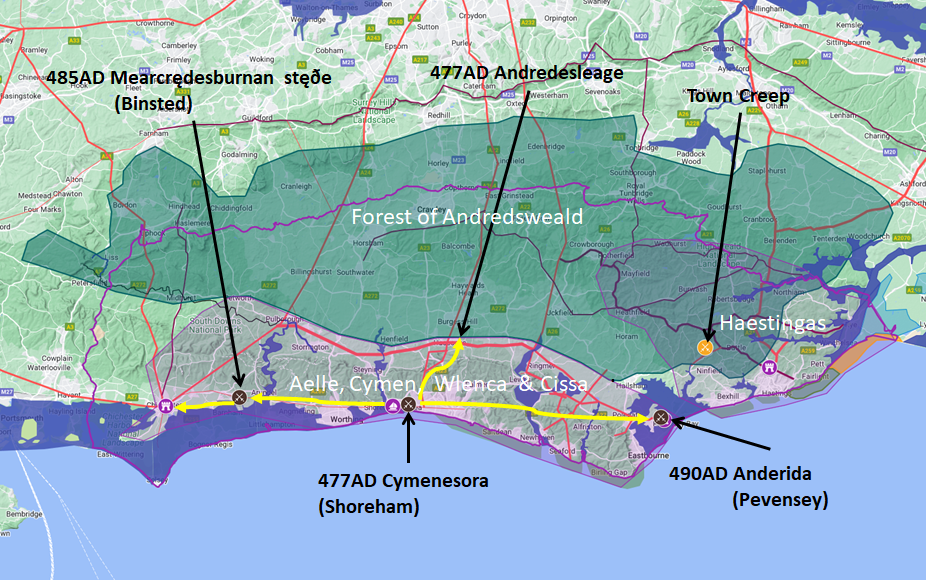|
 | Anglo Saxon History |  | |
| Anglo Saxon Chronicles - 477AD - Cymensora
(Ælle,Cymen, Wlenca and Cissa ) |
|---|
| | The entry from the Chronicles |
|---|
Original text
Her cuom Ælle on Bretenlond ⁊ his .iii. suna, Cymen ⁊ Wlenca ⁊ Cissa, mid .iii. scipum on þa stowe þe is
nemned Cymenesora, ⁊ þær ofslogon monige Wealas ⁊ sume on fleame bedrifon on þone wudu þe is genemned
Andredesleage.
Translation
477AD. In 477AD Aelle came to Britain with his three sons Cymen, Wlenca and Cissa with three ships landing at the
place called Cymensora. There he killed many Welsh and drove some in flight into the forest of Andredsweald.
| | What does this mean |
|---|
Cymensora has never been officially identified anywhere in Sussex, Hampshire or The Isle of White, but we believe that
Cymensora(Cymens shore) was settled and as it is in a valley on the coast would have been called Cymensora ham (ham
appears to be a settlement in a valley or with a landing stage) which could then be shortened to Soraham by removing
Cymen finally to Shoreham.
If he landed at Shoreham and killed the Welsh(this meant foreigners to the Saxons) and drove them into Andredsweald it
would seem likely that the Welsh escaped using the Roman Road to Portslade, then again on an old Roman road up through
present day Pyecombe and Hassocks and into the Weald heading towards London.
On the other side of the River Adur is Lancing which appears to be derived from "Wlanca ing" which translates to "the
fort built by Wlanca", this would appear to confirm that Aelle landed at Shoreham pushed the Welsh to the East, and set
up a bridgehead fort on the other side of the Estuary to control access to and from the sea via the Adur.
Another factor is that the Welsh were driven into the Weald this means that he could only have landed between Rye and
Havant as the forest of Andredleage only spread from Rye in the east to Havant in the west (see our Andredsweald pages),
and a later Anglo Saxon Chronicle entry states that Port landed at Portsmouth. It would have been unlikely that he could
have landed between Rye and Pevensey, as other documents place the Hastingeas in that area.
Therefore he must have landed in the Arun, Adur, Ouse or Cuckmere valleys as cliffs would have made it awkward to land
anywhere else, the mid point between the Hæstingas/Haestingas/Hastingeas/Hestingorum and Port would have been the Adur
valley.
| | Possible interpretation of the Chronicles |
|---|
Shoreham is a good place for a landing as its away from the major Roman centres of Pevensey and
Chichester, the name can be logically derived and there is a nearby route the Welsh could have escaped into the Forest.
|
Map showing the Battles of Aelle, Cymen, Wlencing & Cissa
|
|---|

Map generated using Google My Maps 2024 - showing the
Landscape, modern Counties and sea in 477AD
Please Note: this map is my interpretation of the Anglo Saxon Chronicles entries relating to Aelle, Cymen, Wlencing &
Cissa and their take over of Sussex, the thin purple line shows the modern Sussex boundary.
Aelle controlled West Sussex up to Andredsweald, and the Haestingas controlled East Sussex both of these areas are
shaded in light purple.
The logic for the coastal changes and the Forest of Andredsweald can be viewed on the following pages:
Roman Roads in Britain
The Great Forest of Andredsweald - Anglo
Saxon Chronicles
Landscape - Was the sea level in Saxon times
at Pevensey 4 to 5 metres higher ?
Was the high tide in Saxon times 5 metres higher
? - the Wash
Landscape - The History of the Romney Marsh in
maps(Pre-Roman to Modern times)
Roman Locations that have not been identified and roads that
just terminate
|
|
|
|
|
| |
|
|
Local Interest
Just click an image |
|
|
|
|
|
|
|
|
|
|
|
|
| |
|
|